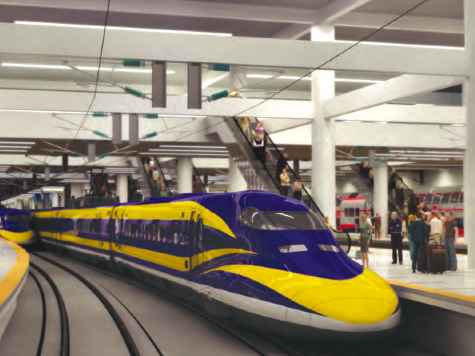The California High-Speed Rail Authority released its draft business plan last week, and opened public comment on the plan on Tuesday. Among the more interesting revelations is a projection, in comments of the official Peer Review Group appended to the report, that the final high-speed train will not meet the actual speeds or times as required by law, in the form passed by the voters of California in Proposition 1A of 2008.
Proposition 1A required that maximum travel time between San Francisco and Los Angeles Union Station would not exceed “two hours, 40 minutes,” and that travel between San Francisco and San Jose would not exceed “30 minutes.” Theoretically, the current design of the high-speed rail would allow it to meet those requirements. However, the high-speed rail would not be “high-speed” along its whole route, at least initially.
Instead, the high-speed train, if and when completed, will only run from San Jose in the Bay Area to the San Fernando Valley near Los Angeles. It will run on slower, normal (albeit electrified and upgraded) infrastructure on the Caltrain network from San Francisco to San Jose, and from the San Fernando Valley into downtown Los Angeles. Passengers would not transfer trains, but would experience slower speeds than advertised.
“[I]it is unlikely that trains would actually be scheduled to run during normal hours of operation within the 30 minute or 2 hours 40 minute limits at the completion of the Phase I Blended system,” the Peer Review Group says.” The comments assume that the slower routes would still comply with Proposition 1A, since the wording of the law provides that the train “shall be designed to achieve” its speed goals–not that it will meet them.
The actual speed between San Francisco and San Jose is projected to be between 37 and 39 minutes–faster than the current 57 minutes, but about 25% slower than advertised. The Peer Review Group does not indicate how much slower the rest of the trip would be, but notes “pure run time” calculations “assume that 220 mph operation through urban areas…will be acceptable to the local communities,” a dubious assumption.
It is unclear if a train that could take more than three hours to travel between San Francisco and Los Angeles would be a viable alternative to air travel or other methods–especially if many passengers must make their way through urban congestion to arrive at the stations. It is also unclear whether the Peer Review Panel’s interpretation of Proposition 1A is legally sound, or whether voters would have approved a slower train at all.

COMMENTS
Please let us know if you're having issues with commenting.